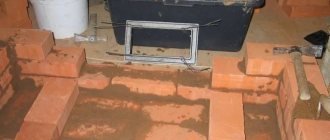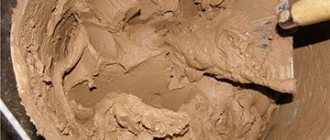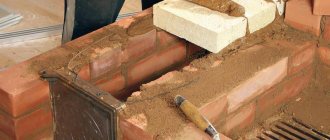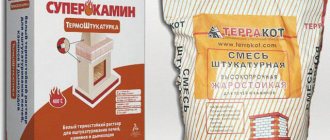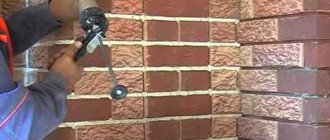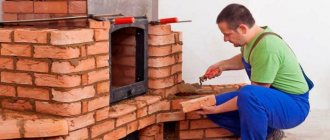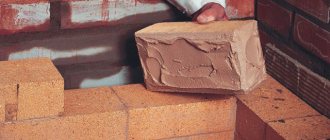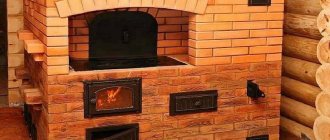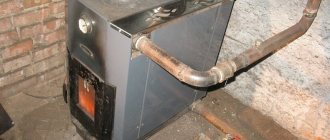Brickwork
I am glad to welcome you, dear reader! Today we’ll talk about how to prepare the right clay solution for a stove or fireplace.
Those who have dealt with the laying of a brick structure are well aware of the procedure for preparing the mortar, which should be prepared not anyhow, but according to all the rules of stove art. A real stove maker can immediately determine whether a mortar for laying stoves is good or bad. To do this, the master just needs to rub it between his fingers.
But it is difficult for a beginner to understand this “competent issue”. And he gets the impression that “brick glue” can be prepared by mixing clay, sand and cement. All this is true, but... The solution for the oven must be prepared correctly.
Features of laying bricks for the stove
Before moving on to the topic of solutions for creating a furnace, it is worth understanding what this work consists of. Firstly, the oven, like any “structure”, consists of a base. Or rather the foundation. It must be strong enough, because the stove is supported on it.
At the same time, the temperature in it can be either 0 C or +1000 C. And if you imagine that cold air enters through the pipe, it will become clear that a simple cement mortar will not withstand the foundation of the device. Next, the stove consists of a firebox and a chimney.
- Creating these three elements is quite labor-intensive work. At the same time, you need a lot of bricks, as well as mortar to hold them together.
- Today this is not a problem; the market offers a large number of ready-made mortars for laying a furnace.
- But they are not that cheap. And as noted above, you need quite a lot of solution.
Therefore, experts in this field (stove makers) advise preparing such mixtures yourself. In their opinion it is not that difficult. The only thing you need to study is the terminology that refers to the substances included in the solution.
Materials and tools
So, what do we need to mix a good solution? First, the tools. With their help, we will knead, sow, lay... Secondly, we need the materials themselves, that is, what we will knead, sow and lay.
Tools: a shovel - for preparing sand and clay, a trowel - mix and use for work, a sieve with a mesh size of 1-2 mm, container (trough, bathtub, tank), a couple of basins, a bucket, a drill or a hammer drill with a mixer attachment.
Necessary materials: clay - the base of the solution, sand - the main filler, cement - the binding component, lime , asbestos , gypsum - auxiliary and additional components (usually not used), clean water .
Terminology
Sand art uses only three terms to name the solution. It is heat resistant in nature. Those. a solution that can withstand fairly high temperatures. When the oven cools, this mixture does not crack and remains in its original form.
Heat-resistant solution refers to a mass that can withstand temperature fluctuations. It is characterized by a smaller amount of thermal deformation compared to the first option.
The refractory solution took away the advantages of the two above substances. At the same time, the appearance of the stove remains the original design, despite the passage of smoke through the chimney and firebox. Based on this, we can draw a conclusion about the solution that is most suitable for laying a stove. Namely, about the heat-resistant and fire-resistant mixture.
Clay mixture
Masonry mortars based on clay, depending on its fat content, are mixed with sand in a certain proportion. The mass should be as homogeneous, finely dispersed and plastic as possible, so that the seam between the rows does not exceed 4 mm. Oily clay cracks when dried and allows waste to pass through, while lean clay collapses under load. Normalization is carried out by adding mountain sand, which is sifted and washed to remove organic matter. The ratio of binder and filler is selected experimentally.
Most often, clay and sand to prepare a workable mass are mixed in a ratio of 1:1 or 1:2 and mixed with water. Bonding 100 bricks will require 30 liters. Oily clay consumes more sand, while thin clay is washed away. Rain and artesian water of medium hardness are added to the composition. A ball is rolled from a test batch and tested for strength. If the sample crumbles when it hits the floor, there is a lot of sand in the mixture.
The fat content of clay for laying stoves is determined using ancient methods:
1. It is necessary to prepare the dough without sand, roll it into a ball and make a flat cake of 5 and 10 cm. The formation of cracks on their surface after 3 days indicates fat content. Sand is added to the composition until normalization occurs. If smooth samples crumble when dropped from a height, the clay is thin and requires the addition of fattier raw materials.
2. The solution is checked for adhesion to the wood cutting. If individual lumps linger on it, the clay for kilns is normal; if it covers evenly, it’s oily; if it leaves a thin layer, it’s skinny.
3. A clay ball (d=6 cm) is placed between wooden plates. With normal fat content, cracks in the cake appear when compressed by 2 cm.
4. Lean dough samples with a length of 10 cm and a cross-sectional diameter of 1 cm have almost no stretch. Oily clay breaks off into pieces with sharp ends. Normal – stretches to a thickness of 8 mm at the rupture site.
You can find the optimal ratio by mixing different varieties and adding sand in the amount determined by the test method.
It’s not difficult to make a clay mixture for the stove yourself, knowing the proportions and sequence of necessary procedures:
The correct ratio of clay and sand can be checked by applying it between bricks. If you lift the masonry and the bottom stone does not come off, the proportions are chosen correctly. The clay solution can be stored in an airtight container for more than a month; when dry, it is soaked in water. To prepare clay of normal fat content, sand is not added. Soaking is done in layers, then filtered through a sieve with three-millimeter holes. The solution is adjusted to working viscosity on site. Mixing can be done on a shield, while the wet clay is laid out on a sand bed and shoveled. The mass is broken, cut and the layers are turned over until a homogeneous mixture is formed. Pour in water and repeat the procedure.
Fireclay clay is used to produce a composition suitable for the characteristics of refractory bricks. Heat-resistant material is obtained by heat treatment of kaolin, which continues after all moisture has evaporated, as a result of which it turns into stone. Pieces of fireclay are crushed and added to masonry mixtures in the form of dry shot (in 20 kg bags). To prepare the solution, refractory powder is poured with artesian water for 2-3 days and stirred periodically. The soaked fireclay clay is passed through a wire mesh to remove large lumps. Mountain sand is poured in parts in a ratio of 1:2. For the heat-resistant option, a fine fraction of crushed fireclay is suitable, which is sifted through cells up to 1.5 mm in size. Then add water until the mass slides off the trowel.
Plumbers: You'll pay up to 50% LESS on your water bills with this faucet attachment
Practical mixture for pipe and foundation
Lime mortar for the oven can be made from ready-made dough, since slaked fluff is only suitable for finishing. They sift out debris and shells from the river sand, and use tap water. Stir the soft lime dough with a paddle. Add clean sand, starting from half the volume. Lime paste is a binding component, and sand provides strength, so its quantity can reach 5 parts.
Plasticity is checked by adhesion to a wooden oar. A normal knead envelops the tool with a layer of 2–3 mm, a thin knead with a thin film, and a fat knead lies in lumps. If the mixture is squeezed out from the seam between two bricks by 1–3 mm, its consistency is suitable for masonry; if not, the composition of the solution is diluted with water, flows down in streams, and lime paste is added.
Foundation mortar
Before making the base for the brick oven, concrete (slab) is placed under it. It is this that ensures that the foundation does not require an expensive solution. A quite familiar one made of cement and lime will do. It is recommended to take red bricks and a whole format.
Popular brands
When purchasing a plaster composition, it is important to pay attention to the following:
- permissible operating temperature limit;
- whether the composition is intended for indoor or outdoor work;
- environmental friendliness of components;
- hardening time;
- resistance to moisture, sudden heating or cooling.
The integrity of the packaging, date of manufacture, and compliance with storage conditions are important.
Heat-resistant plaster for stoves and fireplaces
The following types of brands are the most popular.
PECHFORM PC400 W
Heat-resistant variety. Suitable for lining the flood zone, areas near the hob, side walls of the stove, fireplace.
The maximum permissible operating temperature is 400 degrees. There is no need to additionally putty the surface on top.
Can be used for outdoor and indoor work.
Surface material for application:
- brickwork;
- concrete;
- limestone;
- composite slabs.
5 minutes after mixing the solution it is ready for use and remains suitable for application after 2 hours. Do not apply on top of metal parts.
During operation and drying of the composition, the temperature should be from +5 to +30 degrees. Painting is allowed after 2 weeks.
Typhoon Master
Products from a domestic manufacturer. Heat-resistant plaster is used for finishing walls, chimneys of fireplaces, barbecues and barbecues made of brick.
Has the following properties:
- heat resistance;
- tolerates moisture well;
- plastic;
- convenient for vertical application.
The average mixture consumption per 1 square meter is from 1.6 to 1.8 kg.
Kalina Master
Fireproof plaster. Contains Portland cement. It is characterized by increased strength. Excellent resistance to high temperatures. Quickly sets to the surface. Resistant to mechanical damage.
Pechnik
The base is fireclay clay. Suitable for masonry and finishing of stoves. Hardens quickly. It is used in working with old and new furnaces. Convenient to apply.
It does not collapse when the product shrinks, it is plastic.
Heat-resistant adhesives
Act as a connecting substance for fastening tiles to the surface of a stove or fireplace.
Two types are in greatest demand.
Terracotta
Sold dry. The main raw material is refractory kaolin clay. Does not lose properties at +400 degrees (permissible limit).
It is distinguished by its plasticity, ease of installation, and good adhesion. Used for leveling walls and plastering. All components of the composition are environmentally friendly. It hardens quickly, within an hour after mixing.
The recommended layer thickness is up to 1 cm.
Hercules
Heat-resistant glue. Used for laying fireplaces, stoves, barbecue complexes made of refractory bricks. Suitable for fixing tiles.
Packaged in bags of 5, 12 and 25 kg.
Operating temperature range from –50 to +1200 degrees.
Furnace solution
Or, as it is also called, for the body of the furnace. Which is represented by red brick masonry. For example, brand M 150. It is in the body of the stove that the firebox is located. The body can withstand temperatures of more than +600 C.
But, as practice has shown, the temperature there is less than the indicated figure. But the influence of carbon monoxide and acid sludge is greater. Therefore, clay mortar is chosen for laying the body of the furnace.
As for the firebox, the temperature there is higher than + 1200 C. Therefore, to create it, they use a solution of clay and fireclay, which has a fire-resistant effect.
Pipe solution
Lime mass is all that is needed for laying the chimney. Which in turn is divided into three parts:
- Source. Clay and red brick are used for masonry. Since the temperature does not exceed + 400 C;
- Fluff. The peculiarity is the strength of the structure. Therefore, the mortar is used from limestone, and the brick is solid brick. The element itself is a ceiling from the house to the pipe;
- Smoke pipe and fluff. The chimney is located above the roof, so it is affected by both the high temperature of the smoke emitted and weather conditions. In this case, red brick and lime mass are used. The fluff is placed according to the same principle as a chimney.
Cleaning from impurities
For the stove solution you need clean sand. To separate it from impurities, it must first be sifted and then washed. For sifting, a fine mesh sieve with a mesh size of 1.5 mm is used. Next, the sand is washed as follows: a sack with sagging is pulled onto the holder (you should get a kind of net), into which the sand mixture is placed. The structure is fixed on a stand, sand is poured in and it is washed using a hose and a stream of water. The process continues until the water flowing from the sand becomes clean.
The clay is mixed with water and left to soak.
To remove foreign impurities from the clay, it is washed. Grind, place in the upper part of an oblong container (for example, an old trough or bathtub). The container is installed at an angle of 4–8°. Water is poured into the lower part so that it is at the top and does not touch the clay. Use a small spatula or iron scoop to wash the clay. Gradually it softens and a homogeneous paste-like substance forms at the bottom, which is carefully transferred to another container. The process is continued until the required amount of solution is obtained.
Sand is sifted through a fine mesh sieve
If you purchased packaged dry clay, you need to soak it. The process of saturating clay with water is quite simple. To work, take a wide and deep container, fill it with dry clay to a level of 10–20 cm, level it and add water. The amount of water is so that everything is completely covered. After a day, mix thoroughly with a shovel, add liquid if necessary and leave again for the same period. When everything turns into a paste, the clay is ready. This is repeated several times until all the required amount is soaked.
A little about solutions
Based on the above, you can see expressions such as fireclay, clay, lime, cement, or compounds of some substances from this list. But not everyone knows what properties these mixtures have. Therefore, this will be discussed in more detail below.
Fireclay mixture
Many people classify this mixture as minerals. But this is not entirely true, of course there are minerals there, as well as other elements.
- Fireclay mixture is used for laying the firebox. The mass consists of minerals (garnet, zirconium, etc.) and clay.
- Use it only after complete burning. Even if there is no liquid left in the fireclay.
- The technology involves obtaining a mass with lumps. Fireclay bricks or mortar for laying this material are made from it.
Clay mortar
The cheapest material that can be found in nature for next to nothing. The only thing is that it is difficult to knead. Withstands temperatures up to + 1100 C. Resists fire and has maximum gas density. Suitable for indoor ovens.
Mortar
Here, it is necessary to clarify that it is not pure lime that is used, but slaked lime. Otherwise, you may get cracks in the oven. According to other characteristics, fire resistance and heat resistance are below average, and strength exceeds clay mortar. Used for stoves built outdoors.
Cement and limestone mortar
The mass has low gas density. At the same time, when laying the foundation, it shows its best qualities in terms of its strength.
Chamotte and clay solution
This mass is used for combustion. Withstands more than + 1200 C. It has the properties of a clay solution.
Mortar of cement and chamotte
Here, it is necessary to clarify that the mass is made from high-quality, and therefore far from cheap, substances. As for other characteristics. The mortar is similar in strength to a mass of cement and limestone.
In terms of heat resistance, cement and fireclay are equal to a solution of clay and cement. But the fire resistance is higher than that of other solutions presented above.
This article showed what solutions are used for laying the stove. And she gave advice on what mass for masonry you can save on. Where is it better to overpay to get a stove that will serve for many years.
Determining the quality of clay
The main indicator is fat content. There are fatty and lean clays. When the first one dries, it significantly decreases in volume and cracks, while the second one crumbles.
Clay can be fatty or skinny
Let us immediately note that there is no strictly defined ratio of sand and clay to obtain a good solution. Proportions are determined experimentally, by selection depending on the fat content of the rock.
The fat content of clay rock can be determined in the following way. Roll out ropes of clay, taking a thickness of 10–15 mm and a length of 15–20 cm. Wrap them in a wooden mold with a diameter of 50 mm. If the clay is oily, then the rope stretches gradually, without cracks appearing. Normal ensures smooth stretching of the bundle and breaks, reaching a thickness of 15–20% of the original diameter.
